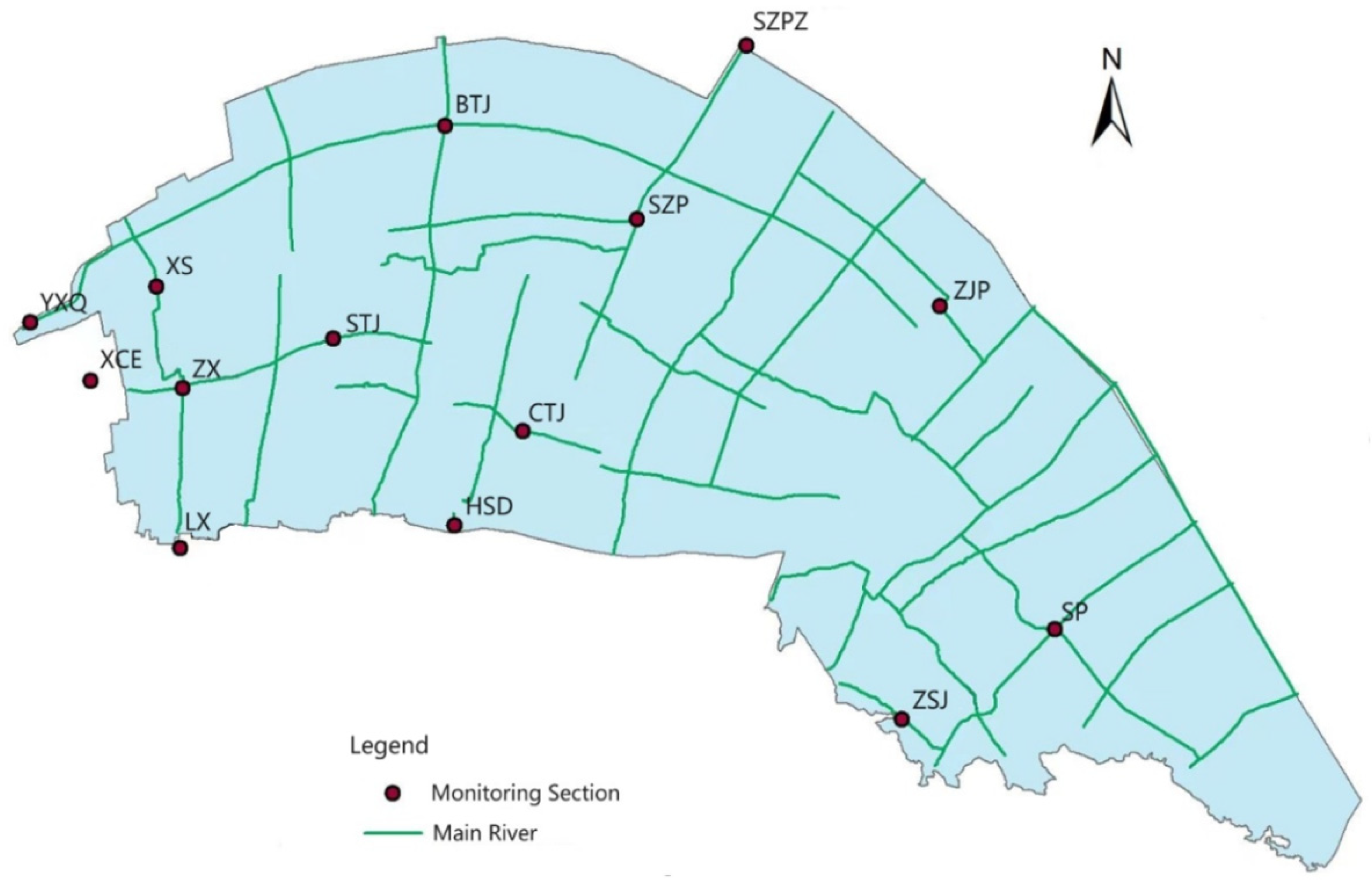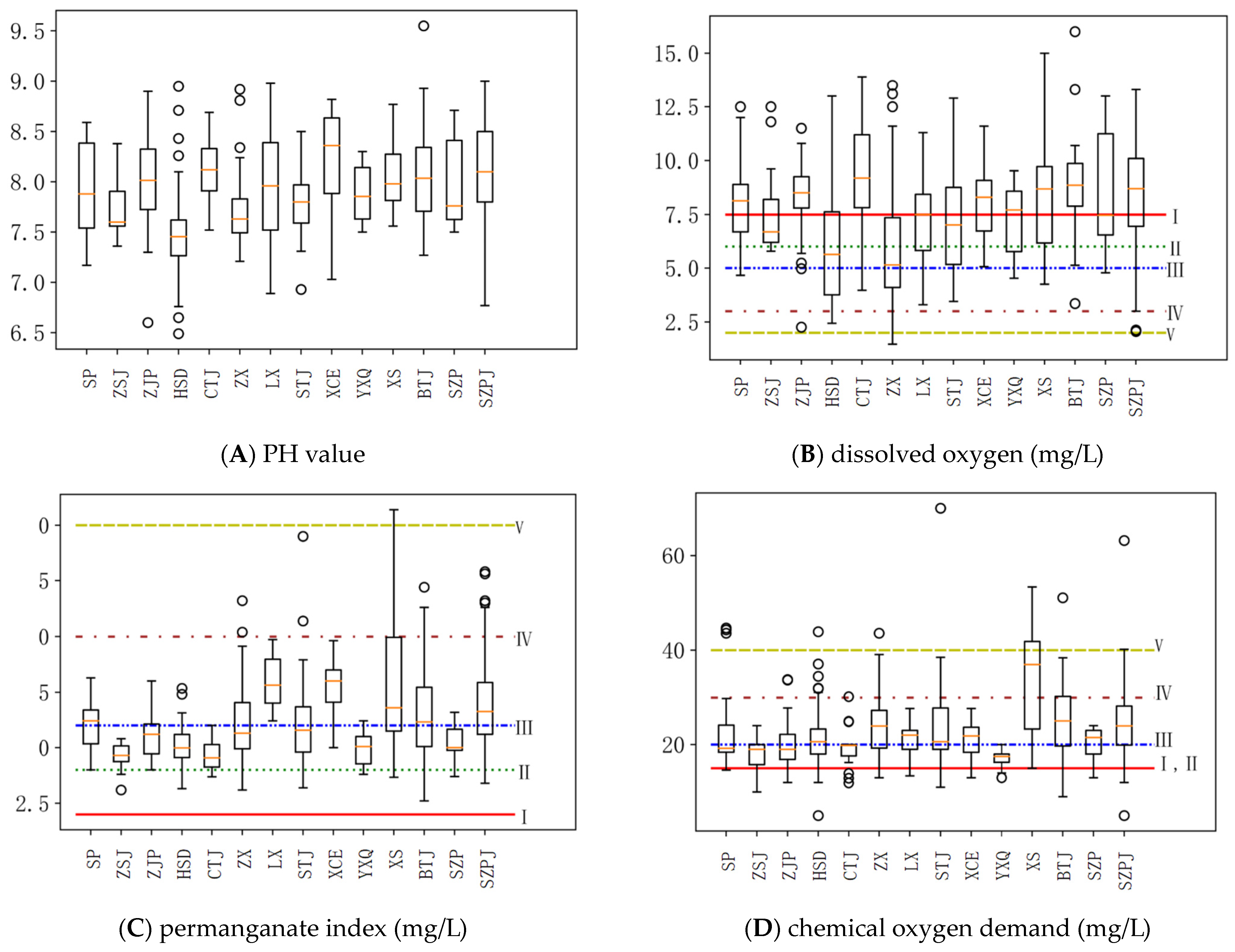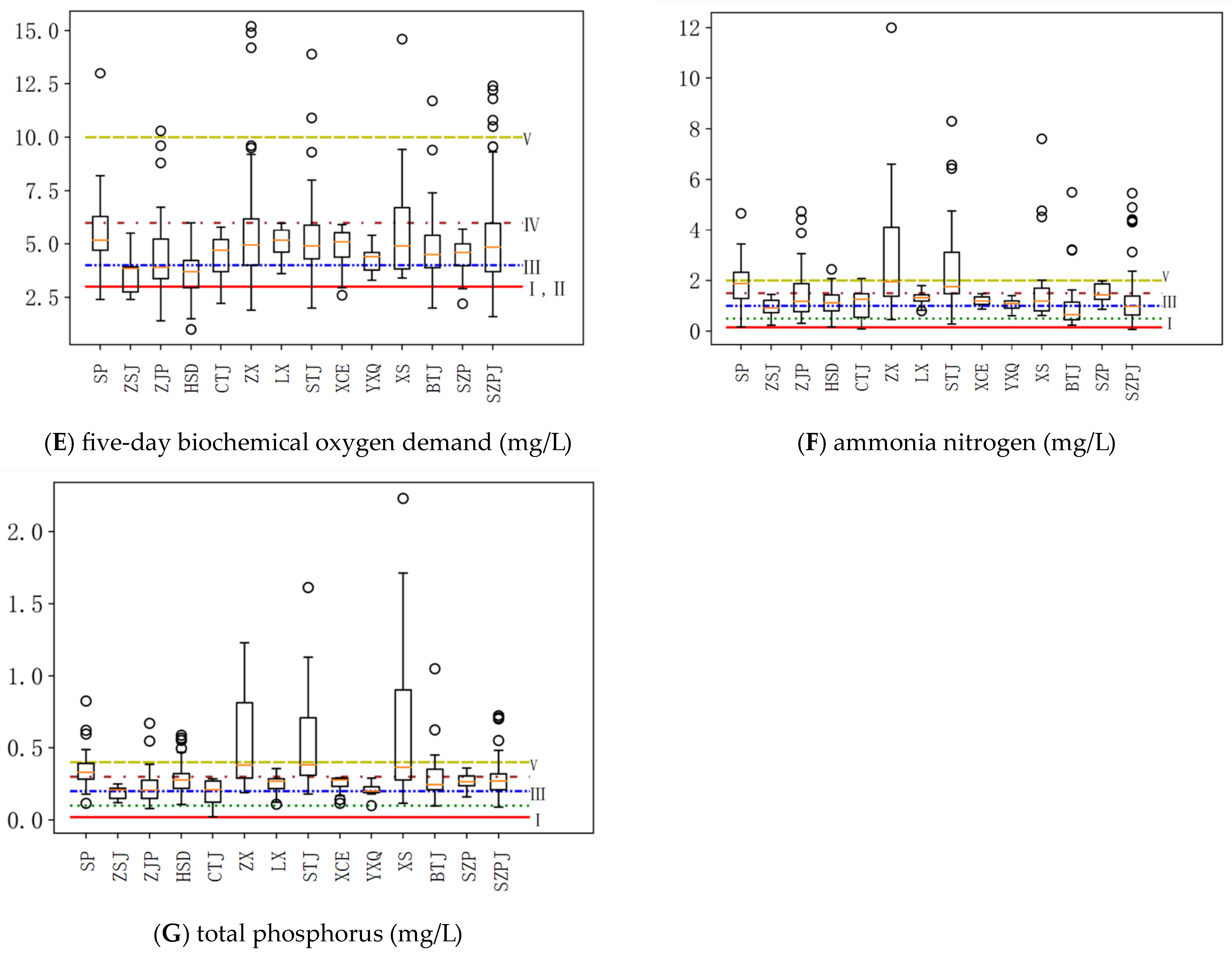Characteristics and Impact Evaluation of Hydrological and Water Quality Changes in the Northern Plain of Cixi, Eastern China, from 2010 to 2022
Abstract
1. Introduction
2. Study Area and Data Description
2.1. Study Area
2.2. River Network and Water System
2.3. Water Environment Monitoring Points and Monitoring Indicators
3. Simulation of River Network Runoff and Confluence
3.1. Calculation of Runoff Yield
3.2. Flow Concentration in River Network
4. Characteristics of Environmental River Water Quality
4.1. The Spatial Difference of River Water Quality
4.2. The Time Difference of River Water Quality
5. Investigation and Driving Force Analysis of Regional Water Pollution Load
5.1. Survey of Pollution Sources
- (a)
- Domestic pollutant
- (b)
- Industrial pollution
- (c)
- Livestock and poultry breeding sewage
- (d)
- Agricultural non-point source pollution
- (e)
- Surface runoff pollutant
- (f)
- Release of internal pollutants
5.2. Analysis of the Driving Force of Water Pollution
- (a)
- Natural factors
- (b)
- Domestic sewage
- (c)
- Industrial pollution
- (d)
- Agricultural pollution
- (e)
- Livestock and aquaculture
- (f)
- Drainage permits and supervision are inadequate
- (g)
- Urban runoff pollution
6. Conclusions
Author Contributions
Funding
Data Availability Statement
Conflicts of Interest
References
- Wang, F.; Dong, W.; Zhao, Z.; Wang, H.; Li, W.; Chen, G.; Wang, F.; Zhao, Y.; Huang, J.; Zhou, T. Heavy metal pollution in urban river sediment of different urban functional areas and its influence on microbial community structure. Sci. Total Environ. 2021, 778, 146383. [Google Scholar] [CrossRef]
- Zou, L.; Liu, Y.; Wang, Y.; Hu, X. Assessment and analysis of agricultural non-point source pollution loads in China: 1978–2017. J. Environ. Manag. 2020, 263, 110400. [Google Scholar] [CrossRef]
- de Lucena Barbosa, J.E.; Severiano, J.D.S.; Cavalcante, H.; de Lucena-Silva, D.; Mendes, C.F.; Barbosa, V.V.; Silva, R.D.D.S.; de Oliveira, D.A.; Molozzi, J. Impacts of inter-basin water transfer on the water quality of receiving reservoirs in a tropical semi-arid region. Hydrobiologia 2021, 848, 651–673. [Google Scholar] [CrossRef]
- Wu, L.; Bai, T.; Huang, Q. Tradeoff analysis between economic and ecological benefits of the inter basin water transfer project under changing environment and its operation rules. J. Clean. Prod. 2020, 248, 119294. [Google Scholar] [CrossRef]
- Zaryab, A.; Nassery, H.R.; Knoeller, K.; Alijani, F.; Minet, E. Determining nitrate pollution sources in the Kabul Plain aquifer (Afghanistan) using stable isotopes and Bayesian stable isotope mixing model. Sci. Total Environ. 2022, 823, 153749. [Google Scholar] [CrossRef]
- Ahamed, S.; Sengupta, M.K.; Mukherjee, A.; Hossain, M.A.; Das, B.; Nayak, B.; Pal, A.; Mukherjee, S.C.; Pati, S.; Dutta, R.N.; et al. Arsenic groundwater contamination and its health effects in middle ganga plain. Sci. Total Environ. 2006, 338, 189–200. [Google Scholar]
- Shi, H.; Lv, R.; Liu, Y.; Xiao, D.; Wang, Z.; Yuan, X.; Liu, L.; Yu, C. Spatial Variability Characteristics and Influencing Factors of Soil Fluoride in the Western Nansihu Lake Basin. Water 2023, 15, 3855. [Google Scholar] [CrossRef]
- Mester, T.; Balla, D.; Szabó, G. Assessment of Groundwater Quality Changes in the Rural Environment of the Hungarian Great Plain Based on Selected Water Quality Indicators. Water Air Soil Pollut. 2020, 231, 536. [Google Scholar] [CrossRef]
- Salah, Z.; Abderrahmane, B.; Lahcen, B. Impacts of natural conditions and anthropogenic activities on groundwater quality in Tebessa plain, Algeria. Sustain. Environ. Res. 2018, 28, 340–349. [Google Scholar]
- Nicolli, H.B.; Bundschuh, J.; Del, C. Blanco, M.; Tujchneider, O.C.; Panarello, H.O.; Dapeña, C.; Rusansky, J.E. Arsenic and associated trace-elements in groundwater from the Chaco-Pampean plain, Argentina: Results from 100 years of research. Sci. Total Environ. 2012, 429, 36–56. [Google Scholar] [CrossRef]
- Sun, L.; Liang, X.; Jin, M.; Zhang, X. Sources and fate of excessive ammonium in the Quaternary sediments on the Dongting Plain, China. Sci. Total Environ. 2022, 806, 150479. [Google Scholar] [CrossRef]
- He, S.; Li, P.; Su, F.; Wang, D.; Ren, X. Identification and apportionment of shallow groundwater nitrate pollution in Weining Plain, northwest China, using hydrochemical indices, nitrate stable isotopes, and the new Bayesian stable isotope mixing model (MixSIAR). Environ. Pollut. 2022, 298, 118852. [Google Scholar] [CrossRef]
- Pang, Y.; He, J.; Niu, X.; Song, T.; Fu, L.; Liu, K.; Bi, E. Selenium distribution in cultivated Argosols and Gleyosols of dry and paddy lands: A case study in Sanjiang Plain, Northeast China. Sci. Total Environ. 2022, 836, 155528. [Google Scholar] [CrossRef]
- Donmez, C.; Sari, O.; Berberoglu, S.; Cilek, A.; Satir, O.; Volk, M. Improving the Applicability of the SWAT Model to Simulate Flow and Nitrate Dynamics in a Flat Data-Scarce Agricultural Region in the Mediterranean. Water 2020, 12, 3479. [Google Scholar] [CrossRef]
- Zhang, L.; Wang, C.; Liang, G.; Cui, Y.; Zhang, Q. Influence of Land Use Change on Hydrological Cycle: Application of SWAT to Su-Mi-Huai Area in Beijing, China. Water 2020, 12, 3164. [Google Scholar] [CrossRef]
- Schilling, J.; Tränckner, J. Generate_SWMM_inp: An Open-Source QGIS Plugin to Import and Export Model Input Files for SWMM. Water 2022, 14, 2262. [Google Scholar] [CrossRef]
- Kim, H.; Amatya, D.M.; Broome, S.W.; Hesterberg, D.L.; Choi, M. Sensitivity analysis of the DRAINWAT model applied to an agricultural watershed in the lower coastal plain, North Carolina, USA. Water Environ. J. 2012, 26, 130–145. [Google Scholar] [CrossRef]
- Jiang, X.; Ma, R.; Ma, T.; Sun, Z. Modeling the effects of water diversion projects on surface water and groundwater interactions in the central Yangtze River basin. Sci. Total Environ. 2022, 830, 154606. [Google Scholar] [CrossRef]
- Zhao, T.; Li, Q.; Lu, L.; Yan, G.; Li, D.; Zhang, W. Analysis of water environmental pollution in plain river network region in small watershed of Caoqiao River. Trans. Chin. Soc. Agric. Eng. 2011, 27, 170–175. [Google Scholar]
- Liu, M.; Min, L.; Wu, L.; Pei, H.; Shen, Y. Evaluating nitrate transport and accumulation in the deep vadose zone of the intensive agricultural region, North China Plain. Sci. Total Environ. 2022, 825, 153894. [Google Scholar] [CrossRef]
- Yao, D.; Tang, G.; Wang, Y.; Yang, Y.; Wang, Y.; Liu, Y.; Yu, M.; Liu, Y.; Yu, H.; Liu, J.; et al. Oscillation cumulative volatile organic compounds on the northern edge of the North China Plain: Impact of mountain-plain breeze. Sci. Total Environ. 2022, 821, 153541. [Google Scholar] [CrossRef]
- Xi, W.; Chang, L.; Yuan, Z. Study of the basic environmental water requirement of the rivers in Huang-Huai-Hai plain. Geogr. Res. 2003, 22, 169–176. [Google Scholar]
- Hong, Y.; Cao, F.; Fan, M.-Y.; Lin, Y.-C.; Bao, M.; Xue, Y.; Wu, J.; Yu, M.; Wu, X.; Zhang, Y.-L. Using machine learning to quantify sources of light-absorbing water-soluble humic-like substances (HULIS_(WS)) in Northeast China. Atmos. Environ. 2022, 291, 119371. [Google Scholar] [CrossRef]
- GB3838-2002; Environmental Quality Standards for Surface Water. National Standard of the People’s Republic of China: Beijing, China, 2002. Available online: https://www.mee.gov.cn/ywgz/fgbz/bz/bzwb/shjbh/shjzlbz/200206/W020061027509896672057.pdf (accessed on 28 January 2024).
- Aredo, M.R.; Hatiye, S.D.; Pingale, S.M. Modeling the rainfall-runoff using MIKE 11 NAM model in Shaya catchment, Ethiopia. Model. Earth Syst. Environ. 2021, 7, 2545–2551. [Google Scholar] [CrossRef]
- Lemaire, G.G.; Rasmussen, J.J.; Höss, S.; Kramer, S.F.; Schittich, A.-R.; Zhou, Y.; Köppl, C.J.; Traunspurger, W.; Bjerg, P.L.; McKnight, U.S. Land use contribution to spatiotemporal stream water and ecological quality: Implications for water resources management in peri-urban catchments. Ecol. Indic. 2022, 143, 109360. [Google Scholar] [CrossRef]
- Hu, L.; Zhao, H. Influence of particle size on diffuse particulate pollutants in combined sewer systems. Sci. Total Environ. 2022, 846, 157476. [Google Scholar] [CrossRef]
- Chen, S.; Sun, B.; Fang, H.; Li, Z.; Tong, A. Analysis of the Roughness Coefficient of Overflow in a Drainage Pipeline with Sedimentation. J. Pipeline Syst. Eng. Pract. 2022, 13. [Google Scholar] [CrossRef]
- Zhou, K. Urban water dissipation calculation based on the improved water balance models. J. Water Clim. Change 2022, 13, 372–382. [Google Scholar] [CrossRef]





| Water Level | Highest Water Level (m) | Warning Water Level (m) | Normal Water Level (m) | Low Water Level (m) | |
|---|---|---|---|---|---|
| Drainage | |||||
| East River | 3.13 | 1.90 | 1.45–1.65 | 0.60 | |
| Middle River | 3.36 | 2.10 | 1.75–1.95 | 0.90 | |
| North of West River | 4.24 | 2.80 | 2.25–2.45 | 1.20 | |
| South of West River | 4.24 | 2.80 | 2.25–2.45 | 1.20 | |
| Northwest River | 4.24 | 3.10 | 2.25–2.80 | 1.90 | |
| Drainage | River | Section | Longitude (E) | Latitude (N) | Monitoring Frequency |
|---|---|---|---|---|---|
| East River | YBHW | SP | 121.48972 | 30.13194 | bimonthly |
| East River | ZSJ | ZSJ | 121.42472 | 30.10056 | bimonthly |
| Middle River | JMP | ZJP | 121.44272 | 30.24835 | bimonthly |
| Middle River | HSJ | HSD | 121.23667 | 30.17194 | bimonthly |
| Middle River | YBHW | CTJ | 121.26583 | 30.20528 | bimonthly |
| Northwest River | QTHJ | YXQ | 121.05833 | 30.24639 | bimonthly |
| Northwest River | LZW | BTJ | 121.23444 | 30.31528 | bimonthly before January 2018 and monthly after that |
| Northwest River | YBHW | XCE | 121.08361 | 30.22500 | bimonthly |
| Northwest River | YBHW | XS | 121.11167 | 30.25861 | bimonthly |
| South of West Rive | YBHW | LX | 121.12083 | 30.16472 | bimonthly |
| South of West Rive | STHJ | STJ | 121.18639 | 30.23944 | bimonthly |
| South of West Rive | ZJLJ | ZX | 121.12222 | 30.22222 | bimonthly |
| North of West River | SZPJ | SZP | 121.31505 | 30.28084 | bimonthly |
| North of West River | SZPJ | SZPZ | 121.36232 | 30.34269 | bimonthly before January 2011 and monthly after that |
| Drainage | Time Frame | Calculation Results of Each Rainstorm Frequency (mm) | ||||
|---|---|---|---|---|---|---|
| 1% | 2% | 5% | 10% | 20% | ||
| East River | H1d | 269.8 | 235.7 | 190.3 | 155.8 | 122.0 |
| H3d | 372.0 | 324.3 | 261.8 | 215.0 | 168.2 | |
| H7d | 454.5 | 401.2 | 331.3 | 277.8 | 223.9 | |
| Middle River | H1d | 241.7 | 210.9 | 170.3 | 139.7 | 109.3 |
| H3d | 387.4 | 338.0 | 272.9 | 223.9 | 175.2 | |
| H7d | 457.2 | 404.3 | 333.9 | 280.0 | 225.7 | |
| West River and Northwest River | H1d | 217.1 | 189.6 | 153.0 | 125.4 | 98.1 |
| H3d | 385.4 | 336.0 | 271.3 | 222.7 | 174.4 | |
| H7d | 438.3 | 386.9 | 319.5 | 268.0 | 215.9 | |
| Drainage | Partition Name | Drainage Area (km2) | Water Production at Different Frequencies (7 Days) (104 m3) | |||
|---|---|---|---|---|---|---|
| 1% | 2% | 5% | 10% | |||
| East River | North Part | 193 | 8097.8 | 7077.6 | 5728.6 | 4698.3 |
| South Part | 124 | 5230.1 | 4570.2 | 3698.0 | 3033.0 | |
| Subtotal | 317 | 13,327.9 | 11,647.8 | 9426.6 | 7731.3 | |
| Middle River | North Part | 183 | 7664.6 | 6706.5 | 5426.5 | 4438.0 |
| South Part | 148 | 6227.2 | 5453.4 | 4422.7 | 3616.6 | |
| Subtotal | 331 | 13,891.8 | 12,159.9 | 9849.2 | 8054.6 | |
| West River and Northwest River | North Part | 107 | 4286.7 | 3738.6 | 3016.0 | 2469.0 |
| South Part | 92.9 | 3768.4 | 3294.9 | 2656.9 | 2182.4 | |
| Northwest Part | 173 | 6897.7 | 6000.6 | 4824.3 | 3939.8 | |
| Subtotal | 373 | 14,952.8 | 13,034.1 | 10,497.2 | 8591.2 | |
| Drainage | P = 1% | P = 2% | P = 5% | P = 10% |
|---|---|---|---|---|
| Middle River (Mountainous area) | 867.3 | 765.3 | 613.1 | 496.6 |
| East River (Mountainous area) | 858 | 757.3 | 605.1 | 505.1 |
| Year | Domestic Sewage | Industrial Wastewater | Livestock and Poultry Breeding Sewage | Total |
|---|---|---|---|---|
| 2021 | 8926 | 2271 | 157 | 11,354 |
| Year | Domestic Sewage | Industrial Wastewater | Livestock and Poultry Breeding Sewage | Agricultural Non-Point Source Pollution | Surface Runoff Pollutant | Release of Internal Pollutants | Total |
|---|---|---|---|---|---|---|---|
| 2021 | 4075 | 279 | 658 | 2195 | 1800 | 448 | 9456 |
Disclaimer/Publisher’s Note: The statements, opinions and data contained in all publications are solely those of the individual author(s) and contributor(s) and not of MDPI and/or the editor(s). MDPI and/or the editor(s) disclaim responsibility for any injury to people or property resulting from any ideas, methods, instructions or products referred to in the content. |
© 2024 by the authors. Licensee MDPI, Basel, Switzerland. This article is an open access article distributed under the terms and conditions of the Creative Commons Attribution (CC BY) license (https://creativecommons.org/licenses/by/4.0/).
Share and Cite
Zhao, Y.; Jiang, M.; Cheng, J.; Jiang, C. Characteristics and Impact Evaluation of Hydrological and Water Quality Changes in the Northern Plain of Cixi, Eastern China, from 2010 to 2022. Water 2024, 16, 489. https://doi.org/10.3390/w16030489
Zhao Y, Jiang M, Cheng J, Jiang C. Characteristics and Impact Evaluation of Hydrological and Water Quality Changes in the Northern Plain of Cixi, Eastern China, from 2010 to 2022. Water. 2024; 16(3):489. https://doi.org/10.3390/w16030489
Chicago/Turabian StyleZhao, Yinghui, Mengyuan Jiang, Jing Cheng, and Congfeng Jiang. 2024. "Characteristics and Impact Evaluation of Hydrological and Water Quality Changes in the Northern Plain of Cixi, Eastern China, from 2010 to 2022" Water 16, no. 3: 489. https://doi.org/10.3390/w16030489
APA StyleZhao, Y., Jiang, M., Cheng, J., & Jiang, C. (2024). Characteristics and Impact Evaluation of Hydrological and Water Quality Changes in the Northern Plain of Cixi, Eastern China, from 2010 to 2022. Water, 16(3), 489. https://doi.org/10.3390/w16030489






